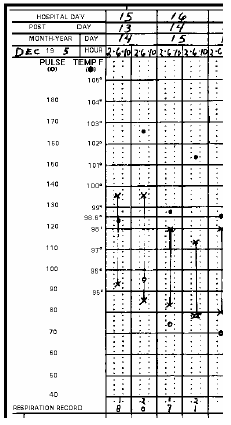 This is the Archived Desktop Edition.
This is the Archived Desktop Edition.
You should be transferred to the Newest Edition for Desktop and Mobile within 2 seconds.
Lesson 6: Recording Vital Signs
Exercises: Lesson 6
EXERCISES: LESSON 6
INSTRUCTIONS: The following exercises are to be answered by marking the lettered response that best answers the question or best completes the incomplete statement, or by writing the answer in the space provided. After you have completed all the exercises, turn to "Solutions to Exercises" at the end of the lesson and check your answers.
1. In the Army, there _______ form on which vital sign information can be recorded.
a. Is only one.
b. Are more than one.
2. Which one of the following forms is a permanent form commonly used to
document a personís vital signs readings each time they are taken while he is a
patient in a military hospital?
a. DD Form 1380.
b. SF 600.
c. SF 511.
d. SF 510.
SPECIAL INSTRUCTIONS FOR EXERCISES 3 THROUGH 7. The information below shows information taken from a block on a DA Form 3950. Use this information to fill in the blanks.
|
128/96 99-80-18 |
3. The patientís pulse rate is ___________.
4. The patientís systolic pressure is ___________.
5. The patientís temperature is __________.
6. The patientís diastolic pressure is ______________.
7. The patientís breathing rate is ____________.
SPECIAL INSTRUCTIONS FOR EXERCISES 8 THROUGH 11.
Based upon the excerpt from an SF 511 shown below, what are the patientís vital signs at 1800 (6 p.m.) on 15 December 1995?

8. The patientís temperature is
________.
9. The patientís pulse is __________
10. The patientís breathing rate is
__________.
11. The patientís blood pressure is:
__________________
Check Your Answers on Next Page
